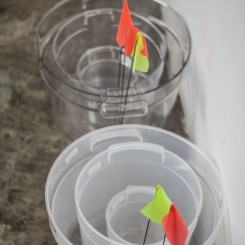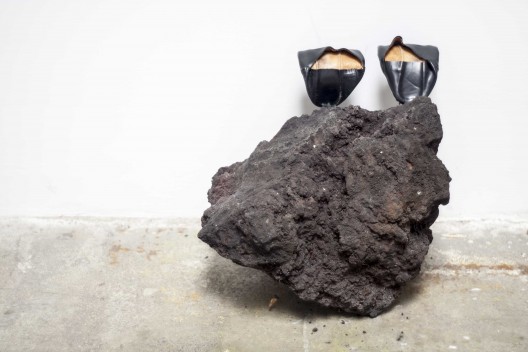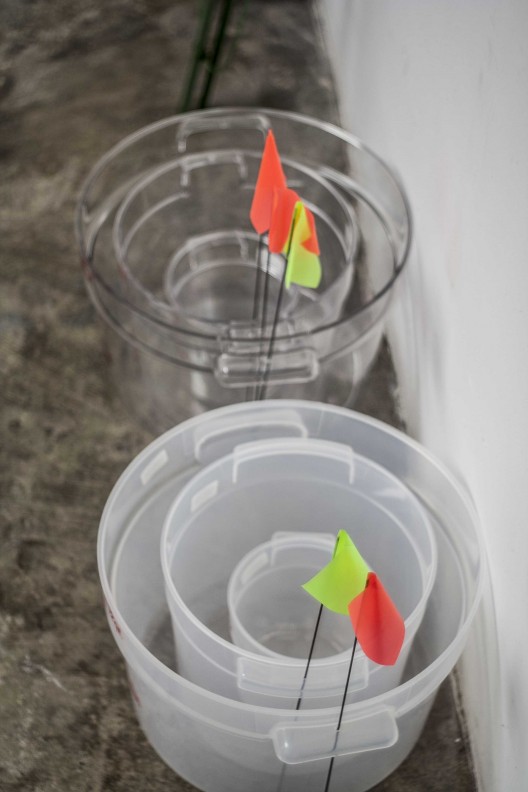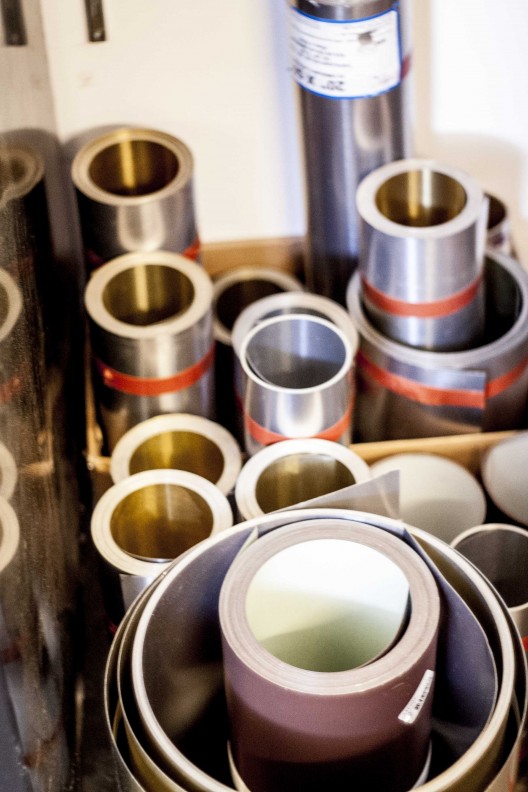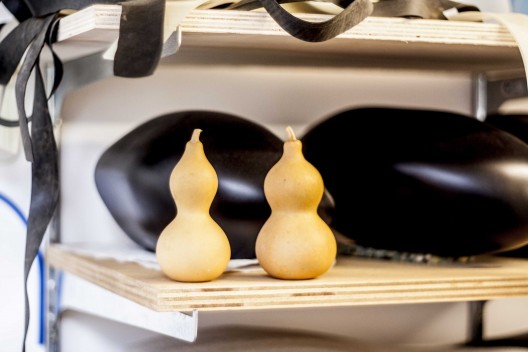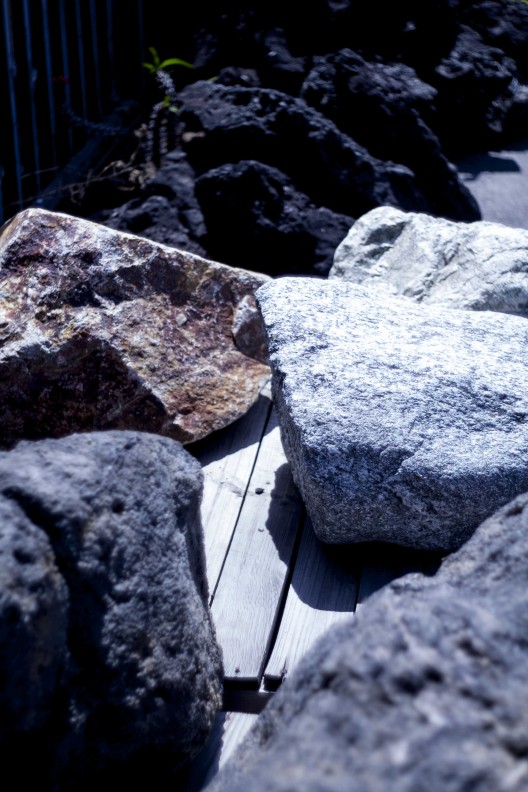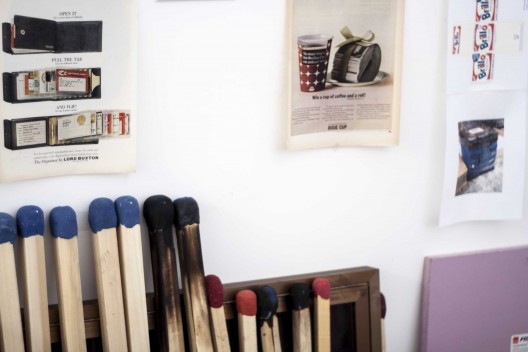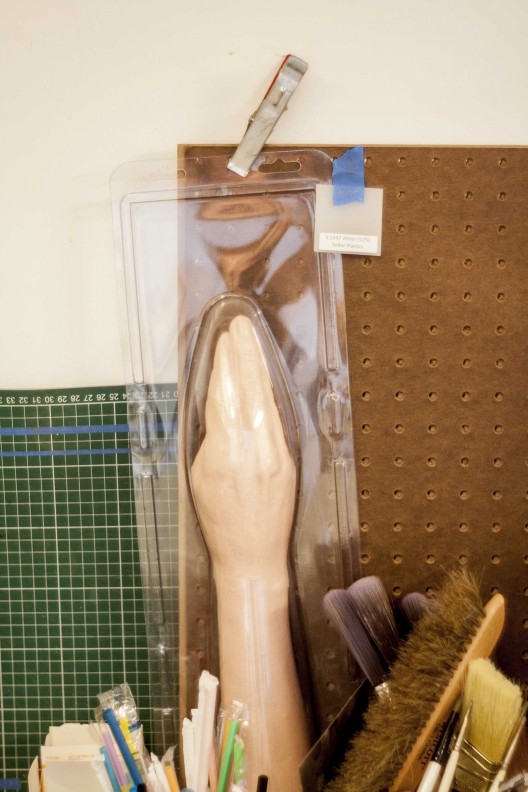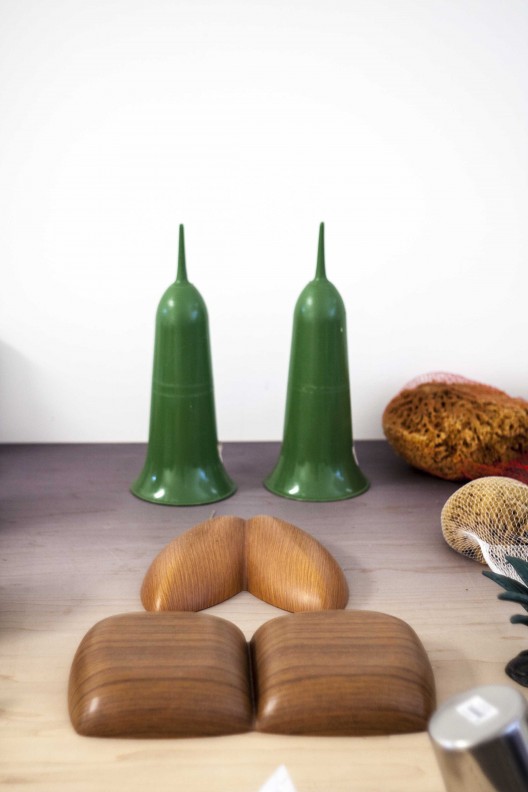This piece is included in Ran Dian’s print magazine, issue 4 (Winter 2016–2017)
We pass through a heavy iron gate and drive into the backyard of Gabriel Kuri’s studio in Culver City, California. Black volcanic rocks and grey stones of similar size—large enough to wrap your arms around—line the boundary where the property is fenced off on the left side. Behind them, I can see what seem to be stone casts of immensely oversize Roman coins, a table and workbench, a perforated, hip-high slab of slate, and two wooden molding constructions that once held the halves and wholes of one-meter-high concrete columns.
On the way to the studio, we pass a metallic filing cabinet that is to be entirely covered and sealed with grainy, blackish-gray waterproofing tarpaper, rendering its function as an accessible container ineffective and emphasizing instead its simple, rectangular form and the inward-reaching slits and protruding lock that will relinquish their services entirely to the tight envelopment of tar sheeting. “It’s an amazing material,” Kuri says. “It looks like elephant skin.” I wonder whether there is an intrinsic correlation between filing cabinets and elephant skin that I had missed, or whether pure visual/haptic satisfaction settled his choice of material. I think of human qualities implied by tarpaper rolls and expressed by filing cabinets, and how their marriage creates a very particular feeling, a statement about the interplay of different qualities. What is meant to protect turns into something that imprisons; what is intended for storage is reduced to mere surface. Smooth becomes rough, and function turns to form; this fusion of selected materials and objects and their particular traits has the effect of loosening and transforming their associated meanings.
The studio is a clean space, an ordered one. Sundry materials are neatly stacked to the left; a kitchenette, tool cabinets, and maisonette desk space are on the right. My eyes hover over the objects, both purchased and found, brand-new and well-used. There are plastic Mexican lunch boxes in bright colors; simple clipboards in brown and silver; boxes of old magazines; dark green dinner plates with a matte finish; nearly identical walking sticks of slightly different lengths and with color stickers; stairwell posts in brass; fishnets in green; black trays inscribed with golden “Thank yous”; oversize matches (burned and unburned); wooden boxes painted yellow, pink, and off-white; vibrant green rubber lettuce leaves; number plates and number cards; faux-wood snack bowls; pink latex implants; beige seashells; enlarged black beans; and rolls and rolls of building material—some soft, some stiff, some metal or plastic or gold-coated, or tempting for some other reason.
On the desk to the rear of the studio, Kuri carefully places a pile of cellophane-wrapped, laptop-size cardboard boxes containing paper replicas of shirts and ties, fruit plates, and lunch foods or coins and gold watches, earthly goods burned for ancestors in some Asian religions which he got in New York’s Chinatown just the week before. The bright orange price tags are still in place, and will possibly remain an integral part of the object.
I suggest we begin with the handshake.
“It’s physical language,” Kuri says. “It suggests the sealing of a deal. It’s more than a ‘hello,’ but rather a performative interaction that anchors a point in time at which a line is crossed and beyond which something takes effect.”
Thus we seal the deal. Hello.
He continues to elaborate on the perfect visual geometry of a handshake: an equation that is solved “as if hands were made to lock into one another.” I had noticed the two engaged hands in the catalog entitled With Personal Thanks to Their Contractual Thingness (2015), and he had flipped this image upside down in order to transform it into something else. For his collages of existing images, Kuri usually intervenes only slightly, a mere disturbance that allows for perceptual registration: a bent corner, an added ticket, a tear, a cut, some small piece of information. When I ask him whether his reaction to found imagery is a formal one, he answers, “I feel like some sort of a participant or witness when I fill in that significant space that an image has to offer, when there is still something for me to do.”
But it is more than merely performing formal actions: visual elegance is only one part of the artist’s work. Kuri is a sculptor but not in the classical, monumental sense. I would also call him an interventionist, a dancer, and a conductor.
I first encountered Kuri’s work in depth in autumn 2015, while assisting with preparations for his solo show “An old niche for your new need?” at Esther Schipper, and I hoped that it would be about things becoming what they actually are, rather than what their function was or the desires bestowed upon them. I wanted it to be about the poetics of materials, an opera of forms and hues, a return to origins and an abandonment of purposes, agendas, and tasks. But I quickly understood that even if one peels away all the layers of every element occupying a position within his sculptural installations, they would still be part of the meaning of the ensemble. And so I darted in both directions: inward, to consider a stone’s intrinsic traits, and outward, to consider its meanings and interconnections within an ensemble. Precisely because there is such little intervention, Kuri’s works force the viewer to adopt an acute state of sensitivity in which the materials and their myriad traits, functions, or relations can be felt and gauged.
In the studio he had placed a pair of worn black leather slippers (his own) next to a large, volcanic rock. The following day, he wedged them between the top of the rock and the wall so that they formed two boughs. In both configurations, I anticipated the items’ nature, either by themselves or within their arrangement. I felt the weight of the rock as a natural, unaltered material, with its uninviting jagged surface and dark black coloring, and imagined the landscape it once lay in. In opposition to it were the man-made slippers, light brown on the inside, with their soft and flexible leather and an apparent connection to home. A comforting feeling arose, which may be perceived as a direct challenge to the uncomfortable weight conveyed by the stone. His works are poetry rather than prose, and the elements are not cemented by narrative but linked through the relationship they form with each other. As such, and as Catherine Wood suggests in her essay,[1] this is also surreal in the sense of marrying two otherwise inequitable entities or circumstances in order for them to be transformed and for something other to be revealed.
Kuri often merges uneven entities at an interstice—an uncomfortable or transitional point of tightening where accumulation may occur and to which the gaze is directed and halted. I continued staring at the tips of the slippers that only just kept the boughs in place. There was a sense of instability, an impression that they might recoil and straighten at any moment. Collected coins and cigarette butts were slipped just deep enough in between the pages of a telephone book (“Untitled”, 2014) or the slits of a letterboard (“coin and cigarette butt board HLRP02”, 2014) to keep them suspended. But only just. A minor quiver and all would fall, shift, and change. I engaged with this tension in the fragile equilibrium Kuri constructed, and suddenly understood the weight and significance of a seemingly minor change of position.
In constructing his works, Kuri touches his materials only about three times—but he makes those few moves count. The diligence and velocity with which he intuitively places, arranges, and mounts objects resemble a silent blow or a perfectly aimed shot, like a dance between the artist, his raw materials, and the surrounding space. This dance is also a negotiation. There is little interest in physically transforming the matter beyond recognition; rather, its inherent physical behavior is put on display. “I like to work with the materials as they come,” he says. “It’s what attracts me to them.” It is Kuri’s thorough understanding of his media, its tonal impact and affiliations, which allows him to orchestrate the various elements into harmonies and disharmonies: “I don’t strive for balance; I very often like to have a feeling of asymmetry in the exhibition, so that the air is somehow more vulnerable. Everything correlates within the space. Anything you move has an effect on the entire constellation of exhibits and the air around it.”
His striving for balance is economical—economical beyond the monetary. Kuri’s work exposes and assesses transactional and relational mechanisms in the world of exchange, referencing means of measurement and distribution as well as incorporating data along with personal, factual information in the form of bank checks, tickets, or number plates. These tidbits of printed matter function as containers, as do letterboards, plastic bags, or enlarged black beans (all items in Kuri’s work), containers for information and associations. Mostly these items are found, collected, and used as they are, but occasionally he transforms them, as with the receipts that are turned into large, soft blankets. The information recorded on a fleeting paper receipt is suddenly rendered more permanent and at the same time less factual. Similarly, it is the enlargement of an insignificant black bean to the size of a human head that makes us consider the associations that lie within. Daniel McClean very fittingly refers to Kuri as the undercover economist,[2] and it is perhaps his playful seriousness that earns him that title.
We talk about time, space, and movement with regard to his work and agree that it is both fast and slow, here and there; fast execution, slow conception. “Art is activated in more than one motion,” says Kuri, “like when you stand in front of it or when you think about taking it home.” His work continues to take place. Even in completion it is not finished. It remains open for discovery and yet is not ambivalent; despite being whole, it is never sealed. Kuri underlines how, in one way or another, each work offers the viewer a contract through which it takes a particular form and spells out the mode of engagement. There is always an invitation, but there are principles and boundaries as well.
Spending time at the studio among new works while perusing Kuri’s many catalogs (my favorite title: Soft Information in Your Hard Facts, Museion Bozen, 2010), I became aware of how some materials, gestures, or objects reoccur as elements in his sculptures not unlike a vocabulary—an alphabet that has been carved out over time. Although this may be accurate at any moment within Kuri’s practice, they make up an open-ended alphabet that expands and adds extra letters. “I get more excited by diversity than absolute concentration on one element,” says Kuri, and I must acknowledge that he is not obsessive in the monastic, repetitive sense. Yet there is devotion—a love, even—which signals an understanding that his chosen forms are not exhausted and never will be. Rather than abandoning his shapes and patterns, he chooses to work with them repeatedly in order to excavate ever newer and more compelling aspects that may have been overlooked the first time. It makes me think repeatedly of Georges Perec’s “infra-ordinary”[3]—the extraordinary that lies within the common. When I point this out to Kuri, he smiles: “Well, if you can squeeze complexity from simplicity, then of course you are doing a good job.”
While I wish all art would activate one’s sensory palate and cognitive suit, initiating a process of sensitization and focus, Kuri’s work accomplishes this particularly well. Processes such as these I deem absolutely vital for today’s culture, which that is one of excess and overproduction, and in which there is a consistent loss of sharpness in our sensory experience.
Notes
(1) Catherine Wood, “Sculpture, in Solid Air,” in Gabriel Kuri: Soft Information in Your Hard Facts (Milan: Museion Bozen and Mousse Publishing, 2010).
(2) Daniel McClean, “The Undercover Economist,” in Gabriel Kuri: With Personal Thanks to Their Contractual Thingness (Aspen, CO: Aspen Art Press Museum, 2015).
(3) Paul Virilio, “On Georges Perec,” in The Everyday: Documents of Contemporary Art, ed. by Stephen Johnstone (London: Whitechapel; Gallery Cambridge, MA: MIT Press, 2008). Virilio article originally published in AA Files, no. 45/46 (London: Architectural Association, 2001).



